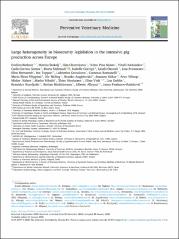| dc.contributor.author | Biebaut, Evelien | |
| dc.contributor.author | Štukelj, Marina | |
| dc.contributor.author | Chantziaras, Ilias | |
| dc.contributor.author | Pina Nunes, Telmo | |
| dc.contributor.author | Nedosekov, Vitalii | |
| dc.contributor.author | Gomes, Carla Correia | |
| dc.contributor.author | Mehmedi, Blerta | |
| dc.contributor.author | Correge, Isabelle | |
| dc.contributor.author | Ozsvari, Laszlo | |
| dc.contributor.author | Svennesen, Line | |
| dc.contributor.author | Bernaerdt, Elise | |
| dc.contributor.author | Toppari, Ina | |
| dc.contributor.author | Gresakova, Lubomira | |
| dc.contributor.author | Romanelli, Costanza | |
| dc.contributor.author | Filippitzi, Maria Eleni | |
| dc.contributor.author | Meling, Siv | |
| dc.contributor.author | Angjelovski, Branko | |
| dc.contributor.author | Küker, Susanne | |
| dc.contributor.author | Viltrop, Arvo | |
| dc.contributor.author | Đidara, Mislav | |
| dc.contributor.author | Nikolić, Marko | |
| dc.contributor.author | Nicolaisen, Thies | |
| dc.contributor.author | Vink, Eline | |
| dc.contributor.author | Dahlin, Lisa | |
| dc.contributor.author | Kureljušić, Branislav | |
| dc.contributor.author | Baraitareanu, Stelian | |
| dc.contributor.author | Allepuz, Alberto | |
| dc.contributor.author | Prodanov-Radulović, Jasna | |
| dc.date.accessioned | 2025-02-13T12:16:41Z | |
| dc.date.available | 2025-02-13T12:16:41Z | |
| dc.date.issued | 2025 | |
| dc.identifier.issn | 0167-5877 | |
| dc.identifier.uri | https://repo.niv.ns.ac.rs/xmlui/handle/123456789/922 | |
| dc.description.abstract | Implementing biosecurity measures in the pig production is crucial to optimize animal health and reduce antimicrobial
usage. A legal framework may help to ensure all stakeholders understand the need of biosecurity
measures and to implement them correctly. Limited knowledge is available about how implementation of biosecurity
measures is regulated in European countries. Therefore, the aim of this study was to identify which
biosecurity measures were mandatory by national legislation and/or by pig sector organizations of European
countries for the intensive pig production under normal circumstances (i.e. no (threat of) disease outbreaks). A
questionnaire including 51 biosecurity measures, 32 on external and 19 on internal, was developed and sent to
national country representatives. Twenty-four European countries, of which 18 belonging to the European
Union, indicated which biosecurity measures were mandatory by law. Four countries, France, Spain, Italy and
Romania had a single national pig-specific biosecurity legislation, while in the other countries multiple legislations
had to be consulted to complete the questionnaire. In general, there was a high heterogeneity in the
number of measures that were mandatory by law per country. Most biosecurity measures addressed in the national
legislation focused on external biosecurity and were measures that can be easily audited when conducting
a farm visit such as the presence of a hygiene lock, fencing around the farm and the existence of documentation.
A significant (p < 0.001) positive correlation was observed between the presence of external and internal biosecurity
measures in the legislation. Yet, no significant association was observed between the number of biosecurity
measures present in the national legislation and the size of the pig production. Fourteen countries
indicated which biosecurity measures were required by pig sector organizations for intensive pig farms. The
median number of biosecurity measures mandatory by pig sector organizations but not by law was 13 with a
minimum of one measure in Germany and a maximum of 24 in Croatia. Different countries apply different
strategies to increase the level of biosecurity. Further research is needed to investigate the impact of the different
strategies on the implementation of biosecurity on intensive pig farms in the countries. | en_US |
| dc.description.sponsorship | This article is based upon work from COST Action BETTER,
CA20103, supported by COST (European Cooperation in Science and
Technology).
This work was funded by the European Union under the Horizon
Europe grant 101083923 (BIOSECURE). Views and opinions expressed
are however those of the author(s) only and do not necessarily reflect
those of the European Union or the European Research Executive
Agency (REA). Neither the European Union nor the granting authority
can be held responsible for them. | en_US |
| dc.language.iso | en | en_US |
| dc.source | Preventive Veterinary Medicine | en_US |
| dc.subject | Biosecurity measures | en_US |
| dc.subject | Disease protection | en_US |
| dc.subject | Europe | en_US |
| dc.subject | Intensive pig production | en_US |
| dc.subject | Law | en_US |
| dc.subject | Mapping | en_US |
| dc.title | Large heterogeneity in biosecurity legislation in the intensive pig production across Europe | en_US |
| dc.type | Article | en_US |
| dc.citation.volume | 237 | en_US |
| dc.citation.rank | M21 | en_US |
| dc.type.version | published | en_US |

